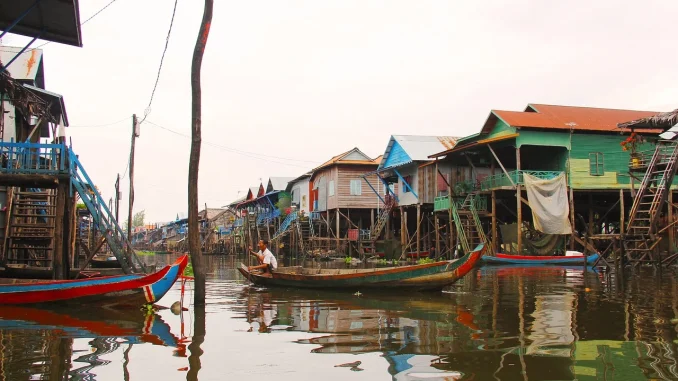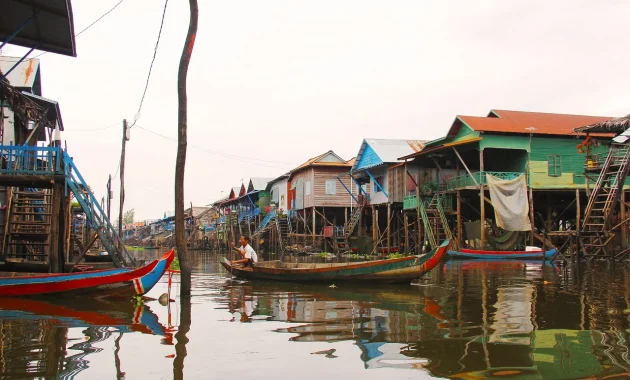
Siem Reap is synonymous with Angkor Wat, one of the world’s most iconic archaeological sites. However, Siem Reap is much more than just a gateway to Angkor. Beyond the temples, this Cambodian city is brimming with hidden gems and authentic cultural experiences waiting to be discovered. Whether you are looking to explore off-the-beaten-path destinations or immerse yourself in local traditions, Siem Reap offers something for every traveler. Let us take you on a journey through the less-known treasures of this captivating city.
1. Explore the Floating Villages of Tonle Sap Lake
While many visitors flock to the temples, the floating villages on Tonle Sap Lake offer a unique cultural experience. Located just a short drive from Siem Reap, the lake is the largest freshwater body in Southeast Asia, and its ecosystem supports thousands of people who live in traditional stilted houses or on floating platforms.
Chong Khneas
Chong Khneas is the most accessible floating village and is often included in tour packages. While it’s more touristy, it still provides insight into the daily lives of the local communities. You’ll see floating schools, markets, and homes, all thriving on the water. If you’re interested in understanding the dynamics of lake life, Chong Khneas offers a convenient starting point.
Kompong Phluk and Kompong Khleang
For a more authentic experience, we recommend visiting Kompong Phluk or Kompong Khleang. These villages are farther from Siem Reap but offer a less commercialized and more tranquil insight into life on the water. Kompong Phluk is particularly fascinating for its mangrove forests, which you can explore by canoe. In Kompong Khleang, you’ll find the stilted homes towering up to 10 meters above the ground during the dry season, giving a glimpse of how the villagers adapt to the seasonal floods.
2. Discover the Cambodian Circus: Phare, The Cambodian Circus
For a night of culture and entertainment, Phare, The Cambodian Circus, is a must-see. This unique performance art group combines traditional Cambodian storytelling with modern circus acts. The artists are graduates of the Phare Ponleu Selpak School, an NGO that helps disadvantaged youth through arts education. Every performance tells a story, often reflecting Cambodia’s history, social issues, or folklore, all while showcasing acrobatics, dance, and live music.
Phare is more than just entertainment; it’s an opportunity to support a good cause while enjoying a world-class show. The troupe’s talents and energy have made it one of Siem Reap’s most beloved cultural attractions.

3. Take a Cycling Tour Through the Countryside
If you’re eager to escape the tourist crowds and get a sense of the Cambodian countryside, consider taking a cycling tour. The areas surrounding Siem Reap are filled with rice paddies, small villages, and local markets, offering a peaceful contrast to the bustling city center.
Several tour operators offer guided bike tours, which allow you to visit places that are inaccessible by car. You can cycle along quiet paths, stopping at local farms, traditional houses, and even handicraft workshops where you can witness artisans at work. These tours often include visits to rural pagodas, giving you the opportunity to interact with monks and learn more about Cambodian Buddhism.
4. Visit the Angkor National Museum
Although Angkor Wat itself is an architectural marvel, the Angkor National Museum provides deeper context and understanding of the Khmer Empire. Located in Siem Reap, the museum houses a vast collection of artifacts, statues, and exhibits that explain the history, culture, and art of the Angkorian period.
The museum is divided into eight galleries, each focusing on different aspects of Khmer civilization, from religion and beliefs to the detailed stone carvings found in the temples. If you’re a history buff or simply want to enhance your knowledge of Angkor, this museum is an invaluable addition to your itinerary.
5. Experience a Cambodian Cooking Class
One of the best ways to experience a new culture is through its food. In Siem Reap, several venues offer Cambodian cooking classes, giving you the opportunity to learn how to prepare traditional dishes such as Amok (fish curry), Lok Lak (stir-fried beef), and Nom Banh Chok (Khmer noodles).
Most cooking classes begin with a visit to a local market where you can select fresh ingredients and learn about essential Khmer spices and herbs. Then, under the guidance of a skilled chef, you’ll prepare a multi-course meal that you can enjoy at the end of the class. Not only do you get to savor your creations, but you’ll also leave with the knowledge to recreate these dishes at home.
6. Discover Artisan Workshops and Handicraft Villages
Siem Reap is home to several initiatives that support local artisans and help preserve traditional Cambodian crafts. A visit to one of these workshops or villages allows you to witness the meticulous processes behind silk weaving, stone carving, woodworking, and lacquerware.
Artisans Angkor
One of the most well-known organizations is Artisans Angkor, which provides training and employment to young Cambodians. At their workshop, you can observe artisans at work, creating beautiful pieces of stone and wood carvings, silk scarves, and lacquered items. You can also purchase these products, knowing that your purchase supports sustainable, ethical craftsmanship.
Puok Silk Farm
Located just outside Siem Reap, the Puok Silk Farm offers a fascinating look into the art of silk production. Here, you can take a guided tour that explains the entire silk-making process, from cultivating silkworms to weaving the final product. It’s an excellent opportunity to learn about a centuries-old craft while supporting local artisans.
7. Visit the Landmine Museum
For a more sobering but important experience, the Cambodian Landmine Museum is worth a visit. Founded by Aki Ra, a former child soldier turned de-miner, the museum educates visitors about the tragic legacy of landmines in Cambodia. You’ll learn about the ongoing efforts to remove unexploded ordnance and how the museum supports landmine victims through education and rehabilitation.
While this museum is a more somber destination, it provides crucial insight into Cambodia’s recent history and the challenges the country continues to face.
8. Watch the Sunset from Phnom Krom
For a serene and less-crowded alternative to Angkor Wat’s sunrise, consider watching the sunset from Phnom Krom. This hilltop temple is located just south of Siem Reap and offers stunning views over Tonle Sap Lake and the surrounding countryside. The temple itself is smaller and less visited than Angkor’s temples, making it an ideal spot for a peaceful end to your day.
The short hike to the top is well worth the panoramic views you’ll get of the Cambodian landscape, especially as the setting sun casts golden hues over the rice fields and waters below.
Conclusion
While Angkor Wat remains Siem Reap’s crown jewel, the city offers much more for travelers looking to explore its hidden gems and immerse themselves in Cambodian culture. From the floating villages of Tonle Sap to the artistry of Phare, the Cambodian Circus, and the craftsmanship of local artisans, Siem Reap is a destination that rewards those willing to venture beyond the temples.